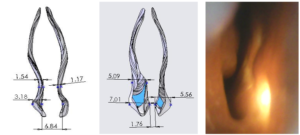Septoplasties can of course be a good thing and since the septum divides the cavities in half the hopeful goal is symmetrical equally sized cavities. Your septum is the other limiting boundary surface guiding and compressing air through your nose. Unfortunately they can also go very wrong. In my case, I had almost ALL of my cartilage removed to the point where my septum is paper thin and I have a hole in it. My voice sounds hollow and is hard to project certain sounds and letters. The worst part is that ENS patients already suffer dryness and less sensation so an “off center” septum makes this issue even worse. When one side is noticeably larger, it sees much more flow and does most of the work, That side never gets to close or rest and dries out. The narrower side is not sharing the work load of conditioning air and loss of sensation is exacerbated by not using what little you have left.
The image below is a scope picture looking into the right side with a flash light illuminating my left side. Light shines through the hole below. 
Prior to any surgeries my septum (above) was around 7mm thick and had a nice soft radius matching that of my inferior turbinates. That rounded structure helped compress the air into, around and up over the turbinate heads into the cavity. Removing that area creates a big gap where air now tumbles in and goes UNDER your inferior turbinates. After 2 surgeries my septum was down to 1.76mm thick!
As a mechanical person I’ve done a lot of machining of metal. If I start with a 1/2” thick piece of aluminum, I KNOW how thick it is. I know where the other side is. I know I can take a 0.100” cut from either side and be left with a piece that is 0.300” thick. How do doctors start blindly grinding away on one side of a septum having no idea how far they are going and where the cartilage ends? Obviously my doctor had no idea and to this day I am stuck with an over opened right side and a narrow left side. There is nothing left of my septum now to even try to move it. When one side is significantly larger especially for an ENS patient it is all the more problematic. In the picture above, the “area” for the right side appears almost double that of the left side.
In terms of any warnings regarding septoplasty surgery I once again found that the description of the process was very misleading. What was described to me was a simple “we’ll straighten your septum”. What actually happens is that tissue is cut, lifted up and they grind away on your cartilage with a “Morselizer”. There is no nice way to put that. If it is necessary and you have a big deformity by all means that is the answer but if it is an add on to turbinate reduction for no good reason I would avoid it.
Lack of symmetry is a common theme that I see in CT scans that people with issues have sent me. What commonly seems to happen is that doctors do things bilaterally and in even fashion no matter what the anatomy looks like. The result is that reducing the ITs by the same amount on both sides yields……. DRUM ROLL PLEASE………….. a LARGER hole on the larger cavity side.
Guilherme J. M. Garcia had this to say in (Atrophic rhinitis: a CFD study of air conditioning in the nasal cavity)
“We suggest that unilateral AR associated with septal deviation may be explained as follows: if the cavity on the concave side of the septum is too large, air will flow mostly through this patent side, subjecting it to a permanent water and temperature gradient. If the water gradient is sufficiently large or the mucosa unhealthy, the mucous layer may dry in regions of high water flux, leading to crust formation and predisposing to infection. Because of the lack of a cyclic closure of the affected side, the continuous airflow is a continuous burden to the mucosa, which will not heal unless artificial irrigation is instituted or airflow artificially obtunded.”
Also: “Clinical observations support this idea: Bunnag and coworkers (5) noted that in AR patients with marked septal deviation, crust is found only in the wider side of the nasal cavity; Gupta (20) reported improvement in the symptoms of unilateral AR after the septal deviation was corrected surgically. This improvement may be due tothe more uniform division of the humidification task betweenthe cavities after surgery. This reasoning suggests that the nasalcycle may have an important role in allowing each cavity torecover after it has been responsible for warming and humidifying the air for a while. This duty of the nasal cycle in providing a rest period for recovery of the nasal epithelium from any damage caused by the airflow has also been proposed by others (4, 12).”
I have had crusting for years and it was indeed worse on the over opened right side. It required the near constant care of spraying saline every 15 minutes all day long. It was no doubt infuriating to present to some doctors regarding ENS and have them not believe me. They would say “You look moist!” “I don’t see dryness or crusting” etc.
